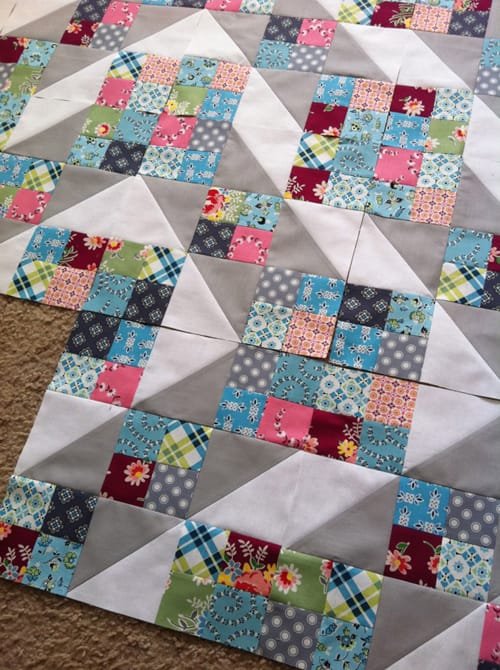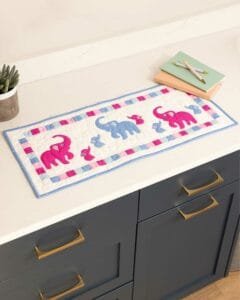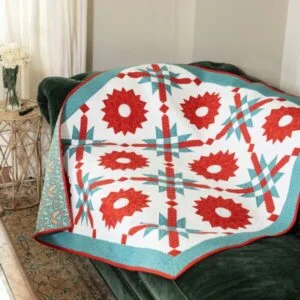Welcome to our comprehensive Jacob’s Ladder Block – Quilt Tutorial! If you’re looking to elevate your quilting skills with a timeless and striking pattern, the Jacob’s Ladder block is a fantastic choice.
This classic quilt block features a mesmerizing geometric design that creates a sense of movement and depth, making it a popular choice among quilters. In this tutorial, we’ll guide you through the steps to create this beautiful block, provide tips for fabric selection, and offer insights on incorporating it into your quilt.
Whether you’re a seasoned quilter or new to the craft, the Jacob’s Ladder block is a versatile pattern that can enhance any quilt project. Its intricate design might look complex, but with a bit of guidance, you’ll be able to master it in no time.

This block’s design often consists of a combination of simple squares and triangles arranged in a way that creates a ladder-like effect, which can add a dynamic touch to your quilt.
By the end of this tutorial, you’ll have a solid understanding of how to construct the Jacob’s Ladder block and how to integrate it into larger quilt designs. We’ll cover everything from fabric choices to cutting techniques and provide answers to common questions about this block. Let’s dive into the details and get started on your Jacob’s Ladder block project!
1. Understanding the Jacob’s Ladder Block
The Jacob’s Ladder Block is a traditional quilt block known for its eye-catching design and geometric precision. Named for its ladder-like appearance, this block creates a sense of depth and movement through its arrangement of simple shapes. The block typically features a combination of squares and triangles arranged to form a visually intriguing pattern.
Key Features of the Jacob’s Ladder Block
The Jacob’s Ladder block is characterized by its interlocking design, which creates a ladder-like effect. This pattern is achieved by arranging squares and triangles in a specific layout, resulting in a block that appears to have multiple layers. The design’s symmetry and precision make it a striking addition to any quilt.
Fabric Choices for the Jacob’s Ladder Block
When choosing fabrics for the Jacob’s Ladder block, consider using fabrics with contrasting colors to highlight the block’s geometric design. High-contrast fabrics can make the ladder effect stand out, while coordinating fabrics can create a more subtle, cohesive look. Experiment with different fabric combinations to find what works best for your project.
Techniques for Cutting and Piecing
Accurate cutting and piecing are essential for creating a well-defined Jacob’s Ladder block. Use a rotary cutter and cutting mat to ensure precise cuts, and pay close attention to seam allowances. Pressing seams open can help reduce bulk and ensure that the pieces align correctly.
Variations of the Jacob’s Ladder Block
There are several variations of the Jacob’s Ladder block that you can explore. Some quilters use different sizes of squares and triangles, while others experiment with fabric placement and color combinations. Each variation offers a unique twist on the traditional design, allowing for creativity and customization.
Incorporating the Jacob’s Ladder Block into Larger Quilts
The Jacob’s Ladder block can be used as a central motif or as part of a larger quilt design. When used as a central block, it creates a dramatic focal point, while incorporating multiple blocks can add rhythm and visual interest to the quilt. Consider how the block will fit into your overall design when planning your quilt.
Tips for Quilting the Jacob’s Ladder Block
When quilting the Jacob’s Ladder block, choose a quilting pattern that complements its geometric design. Simple quilting designs such as straight lines or echo quilting can enhance the block’s features without overwhelming it. Experiment with different quilting techniques to find the one that best suits your design.
2. Fabric and Color Selection
Selecting the right fabrics and colors is crucial for achieving the desired effect with the Jacob’s Ladder Block. Your fabric choices will influence the overall look of your quilt, so it’s important to consider how different fabrics will interact with each other.
Choosing Fabrics for the Jacob’s Ladder Block
Opt for high-quality quilting fabrics that hold their shape and color well. Fabrics with a good drape and durability will result in a more polished finished block. Consider using a mix of prints and solids to add depth and interest to your design.
Color Palette Ideas
A well-chosen color palette can make a significant impact on the final look of your Jacob’s Ladder block. Use contrasting colors to highlight the block’s geometric design or opt for a monochromatic scheme for a more subtle effect. Playing with color gradients can also create a unique visual effect.
Combining Prints and Solids
Combining prints and solids can add visual interest to your quilt. Use prints for the Jacob’s Ladder block to create focal points, and solids for sashing and borders to provide contrast. Ensure that the prints and solids complement each other and the overall quilt design.
Testing Fabric Combinations
Before committing to your fabric choices, create a few sample blocks to test different combinations. This will help you see how the fabrics work together and make any necessary adjustments before starting on the full quilt.
Budget-Friendly Fabric Options
If you’re working within a budget, consider using fabric scraps or remnants. You can create a beautiful quilt by incorporating a variety of fabrics and colors, making each block unique while staying within your budget.
Color Coordination Tips
Use a color wheel to select harmonious colors that work well together. Consider the overall tone and mood you want to create with your quilt and choose colors that reflect that theme.
3. Step-by-Step Guide to Making the Jacob’s Ladder Block
Creating the Jacob’s Ladder Block involves several key steps, from cutting your fabric to assembling the block. Follow this step-by-step guide to ensure that your block turns out beautifully.
Step 1: Cutting Your Fabric
Start by cutting your fabric into the required shapes. You will need squares and triangles for the Jacob’s Ladder block. Use a rotary cutter and cutting mat for precise cuts, and make sure to follow the pattern instructions carefully.
Step 2: Piecing the Squares
Begin by piecing together the squares of your block. Sew the squares together to form the base of the ladder design. Ensure that your seams are aligned and press them open to reduce bulk.
Step 3: Adding the Triangles
Next, add the triangles to the squares to create the ladder effect. Carefully align the triangles with the squares and sew them together. Press the seams open to ensure a smooth finish.
Step 4: Assembling the Block
Once all the pieces are sewn together, assemble the block by joining the pieced squares and triangles. Make sure to match the seams accurately for a well-aligned block.
Step 5: Pressing and Trimming
Press the entire block to set the seams and remove any wrinkles. Trim the block to the desired size, ensuring that all edges are straight and even.
Step 6: Final Adjustments
Check the block for any imperfections and make any necessary adjustments. Your Jacob’s Ladder block should be square and have well-defined edges.
4. Integrating the Jacob’s Ladder Block into Your Quilt Design
Once you’ve mastered the Jacob’s Ladder Block, it’s time to think about how to incorporate it into your larger quilt design. This block can be used in various ways to create a stunning quilt.
Designing Your Quilt Layout
Consider the layout of your quilt and how the Jacob’s Ladder blocks will fit into the overall design. You can use the blocks as a central motif or arrange them in a pattern that creates visual interest.
Combining with Other Blocks
The Jacob’s Ladder block pairs well with many other quilt blocks. Experiment with different combinations to create a quilt that showcases a variety of patterns and designs. Consider using complementary blocks to enhance the overall look.
Adding Borders and Sashing
Borders and sashing can frame your Jacob’s Ladder blocks and add a finishing touch to your quilt. Choose fabrics that complement the blocks and create a cohesive look. Borders and sashing can also provide a transition between different block types.
Quilting Your Quilt
When quilting your finished quilt, choose a quilting pattern that complements the Jacob’s Ladder blocks. Simple quilting designs can highlight the blocks’ geometric features, while more intricate patterns can add texture and depth.
Binding Your Quilt
Select a binding fabric that complements your quilt design and adds a polished finish. The binding should be applied evenly and neatly to complete your quilt.
Final Touches
After completing your quilt, add any final touches such as labels or additional embellishments. A well-chosen label can add a personal touch and record the quilt’s history.
FAQ
1. What is the Jacob’s Ladder Block?
The Jacob’s Ladder Block is a traditional quilt block known for its geometric design that resembles a ladder. It features a combination of squares and triangles arranged to create a visually intriguing pattern.
2. How do I cut fabric for the Jacob’s Ladder Block?
Use a rotary cutter and cutting mat for precise cuts. Follow the pattern instructions to cut your fabric into the required shapes, such as squares and triangles.
3. What fabrics work best for the Jacob’s Ladder Block?
High-quality quilting fabrics work best for this block. Use contrasting colors or prints to highlight the geometric design. Combining prints and solids can add visual interest.
4. How can I incorporate Jacob’s Ladder blocks into a larger quilt?
You can use Jacob’s Ladder blocks as a central motif or combine them with other blocks to create a cohesive quilt design. Experiment with different layouts and arrangements to achieve the desired look.
5. What are some tips for piecing the Jacob’s Ladder Block accurately?
Accurate cutting and piecing are essential. Use a rotary cutter and cutting mat for precision, align seams carefully, and press them open to reduce bulk and ensure a smooth finish.
6. How should I quilt a quilt with Jacob’s Ladder blocks?
Choose a quilting pattern that complements the block’s geometric design. Simple quilting designs like straight lines or echo quilting can enhance the block’s features without overwhelming them.
Join our VIP broadcast list and gain access to exclusive patterns, all for free. As a VIP member, you’ll receive the best patterns daily, delivered directly to your device. ✨📱 It’s a unique opportunity to stay up-to-date with the latest trends and designs, curated just for you. Don’t miss out on enhancing your projects and discovering new inspirations with the best patterns every day! 🎨🔝
Conclusion
In this tutorial, we explored the Jacob’s Ladder Block and provided a step-by-step guide to creating this timeless quilt block. From understanding the block’s design to selecting fabrics and assembling the block, we covered essential tips and techniques to help you succeed in your quilting project. We also discussed how to integrate the Jacob’s Ladder block into larger quilt designs and offered insights into quilting and binding.
We hope this guide has been helpful and inspiring for your quilting journey. We’d love to hear your thoughts and suggestions—please leave a comment with your feedback or any additional tips you have for working with the Jacob’s Ladder block. Your input helps us create more valuable content for the quilting community. Happy quilting!



